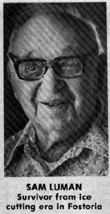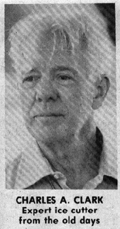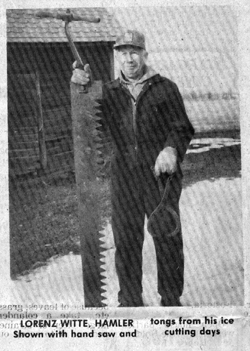August 12, 1982



Picture #1 – Sam Luman – Survivor from ice cutting era in Fostoria
Picture #2 – Charles A. Clark – Expert ice cutter from the old days.
Picture #3 – Lorenz Witte Hamler – shown with hand saw and tongs from his ice cutting days.
Author’s Note: This is the second and last installment on ice production continued from last week.
How I came upon the photo showing the ice storage houses at Reservoir No. 2 is another interesting part of the long search to bring all the elements of this story together. I had searched for such a photo but without success until about eight or nine months ago when I had a telephone call from Charles Mizen, Bascom.
He explained that at Atlas, where he works, often someone on breaks will have a copy of The Review Times with a Potluck article, which is usually the subject of discussion. He then told me that he had a set of books with historical photos of this area and thought I might like to see them. In one of the books, there was an excellent photo of Reservoir No. 2, the Waterworks old tower, also the ice storage houses used with this story.
In my earlier research, I had discussed the subject with Harold Davis, Lakeview Drive, well-known Fostorian and regular reader of Potluck. I later showed him a copy of the photo showing the ice storage houses and he exclaimed “that’s them”.
Only the old-timers will remember how ice was utilized in the home to preserve food. Someone invented the ice check, ice refrigerator, or whatever you may choose to call it. They were wood cabinets, approximately 4 1/2 feet high. the blocks of ice were put in a compartment on the top or side, the opening being a hinged on top or a door in the front.
The ice chilled the interior air and it flowed downward through openings to keep the food placed on shelved cool. As the ice melted the water dripped through a tube to a pan placed under the refrigerator.
Consumers got their ice by horse-drawn delivery wagons, and later by trucks. I remember going to the ice house with my little red wagon. Consumers had a card they would place in the window or door facing the street, indicating if they wanted ice. The card was made so that it could be rotated to show figures – 25, 50, 75, 100 (indicating pounds) – of ice they wanted.
When the ice man came, the kids in the neighborhood gathered to get the small splinters of ice which often was available when they cut a large cake of ice into small sizes.
Without an ice refrigerator, the butter (or margarine) became soft, and milk didn’t keep very long. Meat and other perishables also spoiled. Every household with an ice refrigerator had an ice pick to chip ice from the large cake to provide iced drinks. At our house, we still have a silver butter dish with a lower compartment for chipped ice to keep the butter from melting on hot days.
While I was scrambling around trying to locate all the photos and information for this article, Wilfred Lonsway, South Poplar St. and a regular Potluck reader, gave me a copy of “Farmland News” published in Archbold. In it was an article about ice harvesting as it was carried in a number of northwestern Ohio communities many years ago.
Through the courtesy of Jerry Rohrs, editor of that publication, we are able to show readers a photo of Lorenz Witte rural Hamler, who is a survivor of ice cutting days. He was only 10 or 11 when he helped his grandfather and father.
Others in the Archbold area who recall their own ice cutting days or the stories passed on to them by others are:
Arthur Gerken, Napoleon, who cut ice from his father’s pond and also from the Maumee River in the early 30’s; Andrew Baker, West Unity, cut ice with a cross-cut saw. His father and grandfather cut ice from their farm pond southwest of Maumee prior to 1918; Jesse Wagner of McClure says his father and five sons cut ice from the Maumee River also.
Glenn Rufenacht still lives near the Howard Miller pond, an old gravel pit, near Pettisville where he and his father in-law cut ice in the early 1920’s. They also cut ice from other ponds in that area. The demand for ice was so great they formed a company and rented operators and machines to do the cutting. Later Rufenacht helped build a machine using a motorcycle engine to run a buzz saw to do the cutting. They also built an elevator to convey the ice blocks to the storage house.
Ice harvesting was probably practiced all over the northern portions of the United States wherever there were rivers, ponds, lakes and reservoirs. Water supply and cold weather were the two ingredients.
Mr. Charles Clark, in his lecture on ice harvesting, points out that at one time ice a leading U.S. export, second only to cotton.
Consumers were not the only ones who benefitted from the use of ice to keep perishable foods in the home. Merchants and the food industry used large quantities of ice also. Restaurants needed ice to keep foods from spoiling. Packers and shippers of meat, poultry and dairy products also used ice for preservation of their products.
Back in those days, nearly every town and city has one or more ice cream manufacturers who needed ice for freezing and packing and for soda fountains.
Business places and offices all had drinking water dispensers which used ice for cooling. And so the list of uses for ice were many. It was almost indispensable and in great demand.
Whether we ever return to ice harvesting days is debatable, however, thanks to Mr. Clark and his efforts to keep the knowledge of the art alive, and if his prediction is true, there will be those who know how to use the tools of the trade.
Mr. Clark in a letter to me received after this article was written, informed me that he has started an Ice Harvesters Club and publishes a quarterly newsletter. Annal dues are $5. Anyone interested can write to Ice Harvesters Club, c/o Nancy redfern, Cedar Falls Historical Society, 303 Clay St., Cedar Falls, Iowa 50613.
Also, Clark is still collecting old ice tools. Write to him at 2 Mortimer Dr., Old Greenwich, conn. 06870 if you have any you wish to part with.
Acknowledgements: Farmland News for photo and permission to reprint data; Sam Luman for local data.